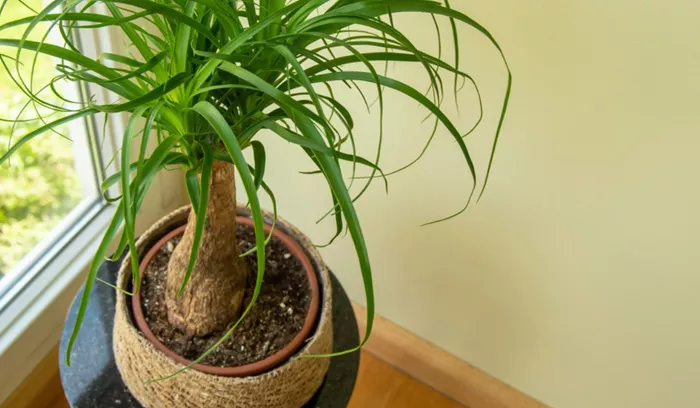The ponytail palm, a captivating plant that graces many gardens and homes, is renowned for its unique appearance and low-maintenance nature. However, few realize the true splendor that lies in its flowering. When in bloom, the ponytail palm transforms from a charming succulent into a botanical marvel. This article delves into the intricate details of the ponytail palm flower, exploring its appearance, significance, and the conditions that bring forth this rare but breathtaking display.
The Visual Splendor of the Ponytail Palm Flower
The ponytail palm flower is a sight to behold, emerging from a plant that is already distinctive in its own right. Typically, the ponytail palm is known for its thick, bulbous trunk that stores water, allowing it to thrive in arid conditions. Its long, arching leaves cascade down like a ponytail, giving the plant its charming name. But when it flowers, the ponytail palm transcends its usual elegance.
Flower Structure and Appearance
The flowers of the ponytail palm are small yet intricate, forming clusters on long, slender stalks that rise above the foliage. Each flower is typically white or cream-colored, with a delicate, bell-shaped structure. The petals are thin and translucent, giving them an almost ethereal quality. When viewed up close, the flowers resemble tiny, delicate stars, each one contributing to the overall beauty of the cluster.
Flower Arrangement and Size
The arrangement of the flowers is another aspect that adds to their allure. They grow in dense panicles, which are branching clusters that can extend several inches in length. The panicles themselves are often held high above the leaves, creating a striking contrast between the green foliage and the creamy white blooms. The size of each individual flower is relatively small, usually no more than half an inch in diameter. However, the sheer number of flowers in each cluster creates a visually stunning display.
The Rarity of the Ponytail Palm Flower
One of the most intriguing aspects of the ponytail palm flower is its rarity. Unlike many other plants that flower annually, the ponytail palm may take several years—or even decades—to produce its first bloom. This long wait period adds to the excitement and anticipation when the flowers finally appear. In fact, many gardeners consider the ponytail palm flower to be a rare treat, a reward for their patience and care.
Factors Influencing Flowering
Several factors contribute to the flowering of the ponytail palm. Age is a significant factor, as the plant needs to reach a certain maturity before it can produce flowers. Typically, a ponytail palm will not flower until it is at least 10 to 15 years old. Environmental conditions also play a crucial role. The plant thrives in well-drained soil and requires plenty of sunlight. Adequate watering and proper care can also encourage flowering, though it is important to avoid overwatering, as this can lead to root rot.
Seasonal Appearance
When the ponytail palm does flower, it usually does so in the spring or early summer. The exact timing can vary depending on the plant’s age and the specific growing conditions. The flowers may last for several weeks, providing a prolonged period of visual enjoyment. During this time, the plant becomes a focal point in any garden or indoor space, drawing attention with its unique and beautiful display.
Cultural and Symbolic Significance
Beyond its aesthetic appeal, the ponytail palm flower holds cultural and symbolic significance. In many cultures, the act of flowering is seen as a symbol of growth, renewal, and perseverance. The ponytail palm’s long journey to flowering can be viewed as a metaphor for life’s challenges and the rewards that come with patience and dedication. This symbolism adds an extra layer of meaning to the plant, making it more than just a decorative element in a garden.
Influence on Garden Design
The presence of a flowering ponytail palm can have a profound impact on garden design. Its unique form and the delicate beauty of its flowers make it a standout feature. Gardeners often use the ponytail palm as a focal point in their landscapes, pairing it with other drought-tolerant plants to create a cohesive and visually appealing arrangement. The plant’s ability to thrive in arid conditions also makes it an excellent choice for xeriscaping, a gardening practice that focuses on water conservation.
Care and Maintenance
While the ponytail palm is generally low-maintenance, proper care is essential to encourage flowering and ensure the plant’s overall health. Regular watering is important, but the soil must be allowed to dry out between waterings to prevent root rot. The plant also benefits from occasional fertilization, especially during the growing season. Pruning is generally not necessary, but removing any dead or damaged leaves can help maintain the plant’s appearance.
Conclusion
The ponytail palm flower is a rare and enchanting sight, transforming an already unique plant into a true botanical gem. Its delicate, bell-shaped flowers and intricate clusters create a stunning display that captures the imagination. While the journey to flowering may be long, the reward is well worth the wait. Whether in a garden or an indoor space, the ponytail palm in bloom is a testament to the beauty and resilience of nature.


